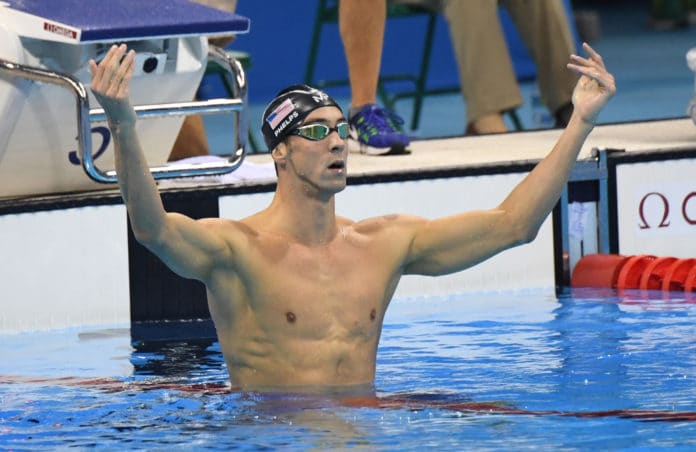NEW LONDON, Conn. (AP) — With the fluid motions of a glass blower, Hong Qi held a flaming alcohol-soaked cotton ball inside a jar for few seconds, then swung the globe onto her patient’s exposed back, pressing it into place.
As the patient lay face down in the East Lyme office Aug. 18, Qi repeated the process until the woman’s back held a dozen upturned jars, each drawing a section of reddening skin into the opening with the suction created by the flame.
“I have six bulging discs, but if I do this a couple of times a month, I’m good to go,” said the woman, who began the treatment for relief from lingering neck and back pain and surgeries needed after a car accident.
“I’m kept pain free, without having to take prescription medications. I can swim, play with my grandchildren, garden,” the woman said. “And it takes care of stress and helps with sleeping.”
The woman, who declined to give her name, said the recent attention to the ancient Asian medical treatment of cupping, after TV appearances by Olympic gold medal-winning swimmer Michael Phelps and other athletes with cupping bruises often compared to large hickeys, gave the procedure a celebrity endorsement she didn’t need.
Among other well-known fans of the practice are several Major League Baseball players and actress Gwyneth Paltrow.
“When I heard Michael Phelps saying cupping is legitimate, I thought, it’s been legitimate for hundreds of years,” the woman said.
Dating back thousands of years in Asian and Middle Eastern cultures, cupping is used in combination with acupuncture to relieve muscle soreness and healing from injuries, as well as promote mental health for those experiencing depression, anxiety and insomnia, said Qi, owner of Hong Qi Acupuncture & Wellness Center, which has offices in East Lyme and Essex.
Patients often receive both acupuncture and cupping as complementary treatments, she said.
“After Michael Phelps, almost all my patients are asking me about cupping,” said Qi, who worked as a neurologist in China before immigrating to the United States, eventually opening her clinic in 2002.
“I’m very excited, because I hope this can help more people,” she said. “The cupping helps move the blood flow in the muscles, which alleviates the pain.”
In Stonington, Megan Marco, owner and clinic director of Stonington Natural Health Center, also has been getting more patient inquiries about cupping.
In addition to burning the oxygen out of the cups before fixing them on the patient, she also applies fragrant oil to the skin so she can slide the cups around the area.
“Cupping is good for manual laborers, and athletes, of course, with really tight muscles,” said Marco, who has operated her business in Stonington for the past 10 years. “I move the cups gently, so the person is able to relax.”
Growing numbers of patients, she said, are seeking cupping and other alternative treatments instead of pharmaceuticals for help with acne, weight loss, smoking cessation, chronic pain and addiction.
Both Marco and Qi use the traditional method of creating suction with flame, but it can also be created with hand pumps attached to specially designed cups.
Martha Briggs, acupuncturist at Norwich Holistic Health Center, said cupping also can be used to help patients with asthma and other respiratory ailments to loosen tight chest muscles.
“Cupping is a way to promote the free flow of blood, and get things moving,” she said. “Michael Phelps was using it to keep his muscles limbered up and loose. It’s a wonderful tool that’s been around for thousands of years. People are coming in now and asking us to do cupping.”
According to the website WebMD, cupping supporters believe cupping removes toxins from the body and promotes healing, but scientific studies are few.
Because the procedure can cause mild discomfort, burns, bruises and skin infections, people are advised to ask their doctor before starting cupping.
Scott Olmstead, physical therapy assistant and athletic trainer at Physical Therapy & Sports Medicine Centers in New London, said he’s had several patients ask about cupping.
At his center, patients are offered Graston Technique treatments— which uses metal bars and instruments to massage muscle and tissue, according to the Graston Technique website —to achieve the kind of results patients are seeking.
But he isn’t against cupping.
“If somebody’s using it, and it makes them feel better, it works,” he said. “It’s like a deep massage, increasing the blood flow and histamines for healing.”
He believes the effects of cupping “are probably short-term,” but he’s not dismissive of patients who’ve had good results.
“The mind is a powerful thing, and if it’s something they believe in, do it,” he said. “It’s better than taking some heavy-duty drugs.”
In Qi’s office last Thursday, a woman who suffers from osteoarthritis said that because of twice-weekly treatments, she has retained her mobility without taking prescription medications.
“I can feel the blood moving in the muscles,” said the woman, who declined to give her name, as Qi applied the cups to the area around her left knee. “It brings a great deal of comfort. As soon as the cups are on, my whole body releases.”
Qi said cupping “motivates an adjustment of your immunity” and helps reduce inflammation.
Patients often use it in combination with Western medical treatments, she said, and more doctors are accepting it.
But, she added, practitioners of alternative medicine, traditional Western medicine doctors and patients alike would benefit from more research about cupping.
“We do need to have more studies,” she said
___






